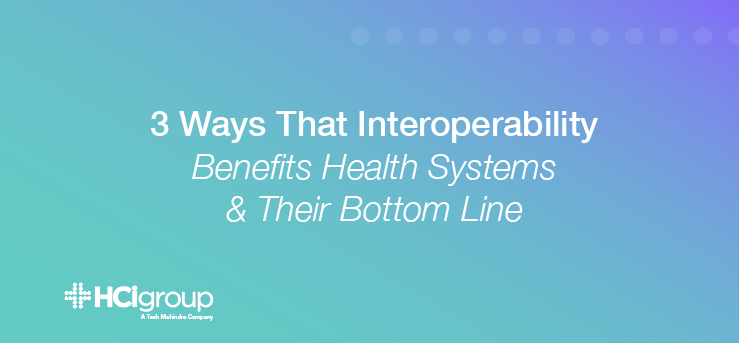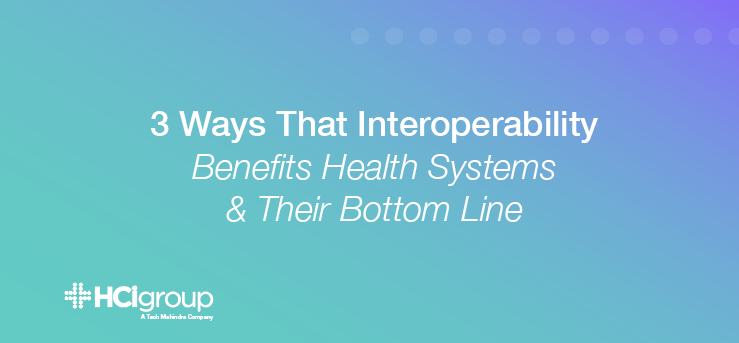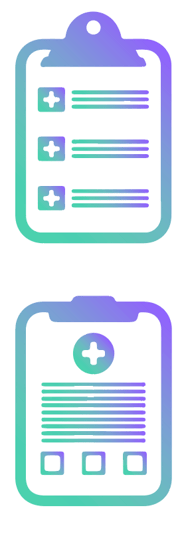3 Ways That Interoperability Benefits Health Systems And Their Bottom Line


When it comes to large health systems, one of the biggest challenges is coordinating care amongst various disparate locations. Especially in the absence of a unifying EHR instance to connect ancillary and core healthcare providers, understanding where a patient is in the care continuum and how to minimize friction as the acutely and chronically ill move between and within treatment facilities is vital. Chasing activity from ED to rehab, PCP to surgical center, ambulatory clinic to ambulance, it gets confusing and messy fast. In the realm of healthcare IT solutions, interoperability continues to be one of the most promising avenues for addressing these challenges. In terms of cost savings and risk management, improving communication of health conditions and streamlining the flow of health information between providers is paramount. Interoperability initiatives and technologies are at the forefront of the promising steps toward realizing true population management and quality care.
Let's examine three specific ways that interoperability initiatives can help healthcare IT efforts truly take root and deliver the cost savings and improved outcomes that we all hope to realize in the very near future.

#1: Interoperability Alleviates Administrative Burden And Patient Pressure
If you’ve spent any time behind the front desk of a healthcare setting, you know all too well the challenge of gathering comprehensive medical records for complex, chronic conditions. (Or for that matter, you’ve been a patient and felt it just as much.) You may have a small piece of the puzzle, but a handful of well-worn lab result copies and a bag full of prescriptions isn’t going to cut it when comorbidities and potential interactions are enough to make the MD on staff consider an admission as the most prudent course of action, given the information...or lack thereof.

Expecting front office staff, intake specialists, and nurses to call a half dozen different providers to assemble a decent medical history to appropriately treat challenging (yet common) cases is not only cumbersome and inefficient, but it’srisky. How confidently can a health system manage their patient population with partitioned data and foggy recollection of appointment-weary patients or loved ones?
Greet Complex Cases With Confidence
Imagine a physician who is able to review a comprehensive medical record, in their respective EHR (right where they expect it to be), updated as regularly as new data is available, walking into the long-awaited appointment with their patient. This is the promise of EHR interoperability in healthcare IT. We know that doctors have less and less time they feel they can spend in their exam rooms, given bureaucratic pressures, decreasing reimbursement, and a sick, aging population that we’re all struggling to keep up with. Any opportunity that we can leverage to better equip these folks on the front line, who we all depend on to keep us well and safe, is a big win that will be felt across the board for everyone in the direct patient care space.
#2: More Efficient Appointments and Less Post-Visit Physician Follow-Up
Speaking of appointments, a big concern for hospitals and clinics alike is thruput. Being able to see enough patients, with a range and mix of conditions and complexities to make the budget sing, is not an easy task. Demand is high, needs are intense, and rooms/beds are often too few. However, interoperability via integrated EHR systems or HIEs (Health Information Exchanges) gives incredible power to care providers and administrators to better utilize what time they have face-to-face, with the full breadth of information in their hands to respond and treat accordingly.
And let’s not forget that many doctors are putting in extensive hours after clinic or post-rounds to catch up on lingering records and delayed results. Having all the info at the right time, when the patient is in context, can make a massive difference in the backlog and review process, not to mention job satisfaction. Interoperability between labs, radiology providers, surgical centers, and other care providers is critical for a connected health system that can truly manage patients versus simply chase them.
#3: Interoperability Reduces Redundant Care And Saves Money
How can we touch on efficiency gained by integrated health IT systems without mentioning redundant care? (We can’t, apparently.) In the absence of a complete health record, providers have to resort to repeated tests, scans, and treatment at times to ensure they’re mitigating risk. Relying on patient recollection is difficult (if not impossible, in some cases), and waiting to address critical concerns for clinics to open and medical records to be faxed (yes….faxed) is not prudent. So when data is lacking, the next best thing is to get the right information, regardless of how recently or how often those steps have already been taken.

Patient records, complete and up-to-date, available at the point of care via interoperable systems are game changing for any medical specialty or condition. Cost savings and patient satisfaction metrics are improved, which means happy campers across the spectrum of stakeholders.
Why Does This Really Matter To A CTO?
Let’s address the question lingering in some of our minds: Why do any of these care concerns rest on the shoulders of the IT Department? In truth, it rests on the shoulders of every health system and hospital department. But many healthcare IT strategy decisions are made with ROI in mind to encourage stakeholders approving the budget. Care delivery and cost containment are the cornerstone of determining whether a given initiative was successful...or not. When it comes to footing the bill for a pricey EHR implementation and health IT infrastructure, you better believe efficiency to meet these goals is a winning concept. Interoperability plays into that strategy, and CTOs can deliver significant results toward ROI by implementing solutions that streamline workflows, improve communication, and elevate the perception of care delivery.
